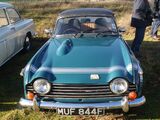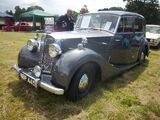(Adding categories) |
(Editing a gallery) |
||
| (One intermediate revision by the same user not shown) | |||
| Line 30: | Line 30: | ||
==Demise of Triumph cars== |
==Demise of Triumph cars== |
||
The last Triumph model was the Acclaim which was introduced in 1981 and was essentially a re-badged Honda Ballade built under licence from Japanese company Honda at the former Morris Motor Company works in Cowley, Oxford. The Triumph name disappeared in 1984, when the Acclaim was replaced by the Rover 200, which was a rebadged version of Honda's next generation Civic/Ballade model. The BL car division was by then named Austin Rover Group, which ended the Morris marque as well as Triumph. |
The last Triumph model was the Acclaim which was introduced in 1981 and was essentially a re-badged Honda Ballade built under licence from Japanese company Honda at the former Morris Motor Company works in Cowley, Oxford. The Triumph name disappeared in 1984, when the Acclaim was replaced by the Rover 200, which was a rebadged version of Honda's next generation Civic/Ballade model. The BL car division was by then named Austin Rover Group, which ended the Morris marque as well as Triumph. |
||
| + | ==Gallery== |
||
| + | <gallery captionalign="left"> |
||
| + | DSC09347.JPG|Triumph world logo |
||
| + | DSC00520.JPG|Triumph Logo |
||
| + | </gallery> |
||
Cars manufactured by Triumph: |
Cars manufactured by Triumph: |
||
Latest revision as of 19:40, 1 October 2012

The Triumph Motor Company was a British car and motor manufacturing company. The marque had its origins in 1885 when Siegfried Bettmann (1863–1951) of Nuremberg initiated S. Bettmann & Co and started importing bicycles from Europe and selling under his own trade-name in London. The trade-name became "Triumph" the year next, and in 1887 Bettmann was joined by a partner, Moritz (Maurice) Schulte, also from Germany. From 1889 the businessmen produced their own bicycles in Coventry, England. As of 2012, the Triumph marque (trade-name) is owned by BMW.
History
Triumph Cycle Company
The company was renamed the Triumph Cycle Co. Ltd. in 1897. In 1902 it began producing Triumph motor cycles at their works in Coventry on Much Park Street. At first these used engines purchased from another company, but the business prospered and they soon started making their own engines. In 1907 they purchased the premises of a spinning mill on Priory Street to develop a new factory. Major orders for the 550 cc Model H were made by the British Army during the First World War, and by 1918 they were Britain's largest manufacturer of motorcycles.
In 1921, Bettmann was persuaded by his general manager Claude Holbrook (1886–1979), who had joined the company in 1919, to acquire the assets and Clay Lane premises of the Dawson Car Company and start producing a car and 1.4-litre engine type named the Triumph 10/20, designed for them by Lea-Francis, to whom they paid a royalty for every car sold. Production of this car and its immediate successors was moderate, but this changed with the introduction in 1927 of the Triumph Super 7, which sold in large numbers until 1934. Probably the rarest (and certainly the largest) of these early period Triumphs was the 15/50 saloon, of which only two known examples remain.
Triumph Motor Company
In 1930 the company's name was changed to Triumph Motor Company. Holbrook realized he could not compete with the larger car companies for the mass market, so he decided to produce expensive cars, and introduced the models Southern Cross and Gloria. At first these used engines made by Triumph but designed by Coventry Climax, but from 1937 they started to produce them to their own designs by Donald Healey who had become the company’s Experimental Manager in 1934.
The company encountered financial problems however and in 1936 the Triumph bicycle and motorcycle businesses were sold, the latter to Jack Sangster of Ariel to become Triumph Engineering Co Ltd. Healey purchased an Alfa Romeo 8C 2300 and developed a new car model with an Alfa inspired straight-8 engine type named the Triumph Dolomite. However the eight-cylinder engine was not used in the production car with the same name.
In July 1939, the Triumph Motor Company went into receivership and the factory, equipment and goodwill were offered for sale. T.W. Ward purchased the company and placed Healey in charge as general manager, but the effects of the Second World War again stopped the production of cars; the Priory Street works was completely destroyed by bombing in 1940.
Standard Triumph
In November 1944 what was left of the Triumph Motor Company and the Triumph trade-name were bought by the Standard Motor Company and a subsidiary "Triumph Motor Company (1945) Limited" was formed with production transferred to Standard's factory at Canley, on the outskirts of Coventry. Triumph's new owners had been supplying engines to Jaguar and its predecessor company since 1938. After a "considerable argument" between Standard-Triumph Managing Director, Sir John Black, and William Lyons, the creator and owner of Jaguar, Black's objective in acquiring the rights to the name and the remnants of the bankrupt Triumph business was to build a car to compete with the soon-to-be-launched post-war Jaguars.
The pre-war Triumph models were not revived, and in 1946 a new range of Triumphs starting with the Triumph Roadster was announced. Because of steel shortages these were bodied with aluminium which was plentiful because of its use for aircraft production. The same engine was used for the 1800 Town and Country saloon, later named the Triumph Renown, which was notable for the styling chosen by Standard-Triumph's managing director Sir John Black. A similar style was also used for the subsequent Triumph Mayflower light saloon. All three of these models prominently sported the "globe" badge that had been used on pre-war models. When Sir John was forced to retire from the company this range of cars was discontinued without being replaced directly, sheet aluminium having by now become a prohibitively expensive alternative to sheet steel for most auto-industry purposes.
In the early 1950s it was decided to use the Triumph name for sporting cars and the Standard name for saloons. In 1953 the Triumph TR2 was initiated, the first of a series that was produced until 1981. Curiously the TR2 had a Standard badge on its front and the Triumph globe on its hubcaps.
Standard had been making a range of small saloons named the Standard Eight and Ten and had been working on a replacement for these. The success of the TR range meant that Triumph was considered to be a more marketable name than Standard, and the new car was introduced in 1959 as the Triumph Herald. The last Standard car to be made in the UK was replaced in 1963 by the Triumph 2000.
Leyland and beyond
In December 1960 the company was bought by Leyland Motors Ltd with Donald Stokes becoming chairman of the Standard Triumph division in 1963. Further mergers resulted in the formation of British Leyland Motor Corporation in 1968.
During the 1960s and 1970s, Triumph sold a succession of Michelotti-styled saloons and sports cars, including the advanced Dolomite Sprint, which, in 1973, already had a 16-valve four cylinder engine. It is alleged that many Triumphs of this era were unreliable, especially the 2.5 PI (petrol injection) with its fuel injection problems. In Australia, the summer heat caused petrol in the electric fuel pump to vaporise, resulting in frequent malfunctions of the 2.5 PI and TR6 models. While the injection system had proved itself in international competition, it did lack altitude compensation for the adjustment of mixture at altitudes greater than 3,000 feet (910 m) above sea level. The Lucas system proved unpopular: Lucas did not want to develop it further, and Standard-Triumph dealers were unwilling to attend factory and field-based training courses dedicated to this propulsion method.
For most of its time under Leyland or BL ownership, the Triumph marque belonged in the Specialist Division of the company, which went by the names of Rover Triumph and later Jaguar Rover Triumph other than a brief period during the mid-1970s when all BL's car marques or brands were grouped together under the name of Leyland Cars.
The only all-new Triumph model initiated as Rover Triumph was the 'TR7, which had the misfortune to be in production successively at three factories that were closed: Speke, the strike-prone Leyland-era Standard-Triumph works in Liverpool, the original Standard works at Canley, Coventry and finally the Rover works in Solihull. Plans for an extended range based on the TR7, including a fastback variant codenamed "Lynx", were ended when the Speke factory closed. The four-cylinder TR7 and its short-lived eight-cylinder derivative the TR8 were terminated when the road car section of the Solihull plant was closed (the plant continues to build Land Rovers.)
Demise of Triumph cars
The last Triumph model was the Acclaim which was introduced in 1981 and was essentially a re-badged Honda Ballade built under licence from Japanese company Honda at the former Morris Motor Company works in Cowley, Oxford. The Triumph name disappeared in 1984, when the Acclaim was replaced by the Rover 200, which was a rebadged version of Honda's next generation Civic/Ballade model. The BL car division was by then named Austin Rover Group, which ended the Morris marque as well as Triumph.
Gallery
Cars manufactured by Triumph:
All items (49)
-
Triumph 10/20
-
Triumph 13/35
- Triumph 1300
-
Triumph 1500
- Triumph 2000
-
Triumph 2500
- Triumph Acclaim
-
Triumph Boxer
-
Triumph Broadside
-
Triumph Bullet
- Triumph Conrero Le Mans
- Triumph Dolomite
-
Triumph Dolomite (1934–1940)
-
Triumph Dove GTR4
-
Triumph Fury
- Triumph Gloria
- Triumph GT6
- Triumph Herald
-
Category:Triumph Images
- Triumph Italia
-
Triumph Lynx
- Triumph Mayflower
- Triumph Renown
- Triumph Roadster
-
Triumph SD2
-
Triumph Southern Cross
- Triumph Spitfire
- Triumph Stag
-
Triumph Super 7
-
Triumph Super 9
- Triumph Toledo
- Triumph TR
- Triumph TR-X
-
Triumph TR1
- Triumph TR2
- Triumph TR250
- Triumph TR3
- Triumph TR3 Speciale
-
Triumph TR3A
-
Triumph TR3B
- Triumph TR4
-
Triumph TR4A
- Triumph TR5
- Triumph TR5 Ginevra
- Triumph TR6
- Triumph TR7
-
Triumph TR7 Sprint
- Triumph TR8
- Triumph Vitesse



































